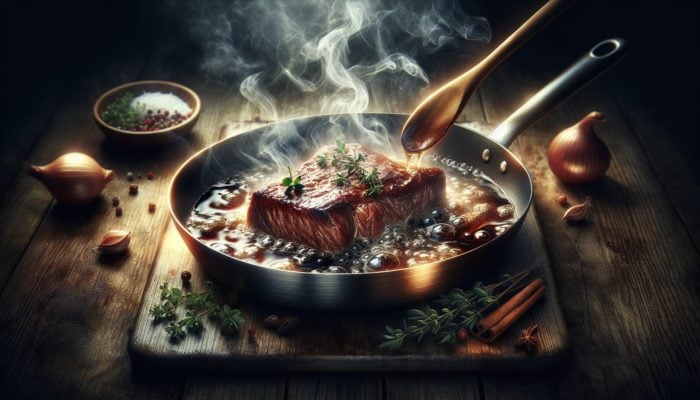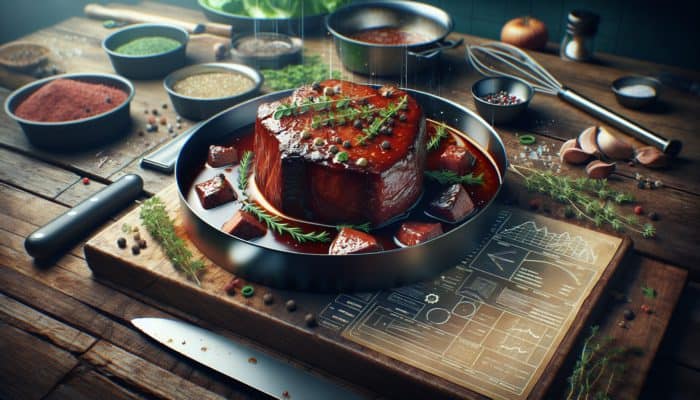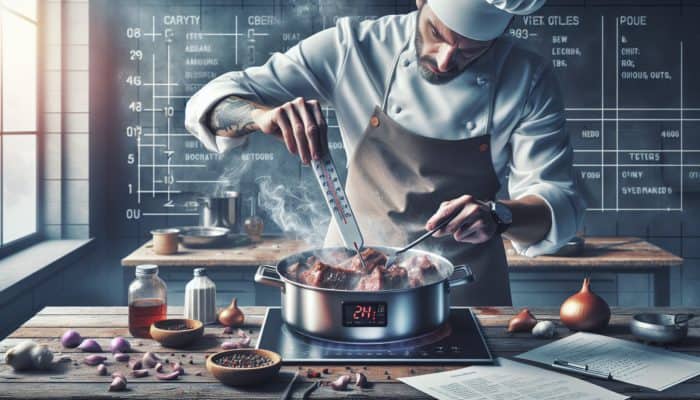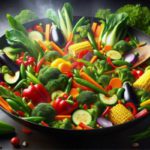Master the Art of Braising: The Comprehensive Cooking Guide You Need
What Is Braising and How Does This Cooking Method Work?

Unveiling the nuances of how to braise meat for irresistibly tender outcomes requires a deep dive into this versatile cooking technique that artfully merges both dry and moist heat. Braising is an exceptional method that transmutes tougher cuts of meat into succulent, flavourful creations. The process initiates with searing the meat in a hot pan, which generates a deeply caramelised crust that is essential for enhancing the overall flavour profile. Following this vital step, the meat is gently simmered in liquid at a low temperature, enabling the connective tissues to gradually dissolve. This two-step approach not only tenderises the tougher cuts but also infuses them with the rich flavours sourced from the braising liquid and accompanying herbs and spices.
The true charm of braising lies in its remarkable adaptability. Chefs can select an extensive range of liquids, from broth and wine to beer or even fruit juices, each representing diverse culinary heritages across the globe. This technique is particularly cherished in cuisines that celebrate the art of slow cooking, including French, Italian, and Asian. Ultimately, the result is meat that is not only tender but also bursting with flavour, enriched by the layers of taste developed throughout the cooking process.
How to Select the Ideal Cut of Meat for Perfect Braising
Choosing the right cut of meat is paramount for achieving outstanding results when braising. Opting for tougher cuts, which are abundant in connective tissue and fat, allows them to break down beautifully during the slow cooking process, yielding succulent and juicy meat. These cuts often come at a reasonable price, rendering braising an economical option for hearty, flavourful meals.
Here are some outstanding cuts to consider for a successful braise:
- Chuck – Renowned for its rich marbling and generous connective tissue.
- Brisket – Converts into an incredibly tender and flavourful dish through the braising process.
- Shank – Rich in collagen, making it ideal for a hearty braise.
- Round – A budget-friendly choice that can produce delicious results.
- Pork shoulder – A popular choice for pulled pork, excelling in braising scenarios.
- Lamb shank – Offers a unique flavour profile that pairs beautifully with braising.
- Oxtail – This rich, gelatinous cut yields a luxurious broth.
- Short ribs – Famous for their depth of flavour and tender texture post-braising.
By opting for these cuts, you can immerse yourself in a world of global flavours and techniques, making braising an exciting and enriching addition to any culinary repertoire.
What Essential Tools Will Guarantee Successful Braising?
Equipping yourself with the appropriate tools is indispensable for effective braising. A heavy-bottomed pot or Dutch oven serves as the ideal vessel, ensuring even heat distribution and consistent temperatures throughout the cooking experience. A tight-fitting lid is also crucial, as it traps moisture and prevents the braising liquid from evaporating too quickly.
In addition to your cooking pot, there are several essential utensils that facilitate the braising process. Tongs are invaluable for handling the meat without losing heat, while a wooden spoon or spatula allows you to stir in aromatics and deglaze the pot effectively. It is also wise to invest in a thermometer, as it helps you monitor the internal temperature of the meat, ensuring it reaches the perfect level of doneness without the risk of overcooking. By having these tools readily available, you will be well-prepared to embark on a successful braising journey, turning tough cuts of meat into tender culinary masterpieces.
Proven Techniques to Achieve Perfectly Braised Meat Every Time

What Are the Essential Steps to Successfully Braise Meat?
Braising is a multifaceted technique that comprises several crucial steps necessary for achieving ideal tenderness and flavour. The key steps include:
- Browning the meat – This initial and critical step develops rich flavour.
- Incorporating aromatics – Ingredients such as onions, garlic, carrots, and herbs significantly enhance the overall dish.
- Deglazing the pan – This captures the delicious browned bits, enriching the sauce.
- Simmering in liquid – This slow cooking method effectively breaks down tough fibres.
By meticulously following these steps, you not only ensure that your meat becomes tender but also infuse it with robust, layered flavours. The browning phase creates a delectable crust that contributes to the overall taste, while the addition of aromatics, including vegetables and herbs, elevates the dish’s complexity. Deglazing allows you to incorporate all those flavour-packed bits stuck to the bottom of the pot, enriching your braising liquid. Finally, simmering at a low temperature enables flavours to meld while gently coaxing the meat into tenderness. Each of these steps plays a vital role in achieving a delightful and satisfying braised dish.
How Can You Enhance Flavours During the Braising Process?
Elevating the flavour during the braising process is an art that can transform your dish from ordinary to extraordinary. While the selection of meat and cooking technique is paramount, the combination of herbs, spices, and liquids can craft distinctive flavour profiles. Experimentation with different combinations can yield delightful and unexpected culinary results.
Consider these flavour enhancement techniques:
- Incorporate fresh herbs such as rosemary, thyme, and bay leaves for aromatic depth.
- Add spices like cumin, coriander, or smoked paprika for a unique flavour twist.
- Utilise citrus zest or juice to introduce brightness and acidity.
- Include umami-rich ingredients like Worcestershire sauce or soy sauce.
For instance, braising a beef chuck roast with red wine, garlic, and thyme can yield a robust dish characteristic of French cuisine. Conversely, employing a blend of coconut milk, ginger, and lemongrass for braising chicken can impart a distinctly Southeast Asian flavour. This versatility allows you to explore the culinary traditions of various cultures, making braising an exciting avenue for flavour exploration.
How to Maintain Optimal Temperature Control During Braising?

Maintaining the ideal temperature is crucial for achieving tender results in braising. The essence of this technique is to cook meat at a low simmer, typically between 150 °C and 180°C (300°F and 350°F). This gentle heat effectively breaks down connective tissues without drying out the meat, ensuring it remains moist and tender.
Here are some actionable steps to maintain the perfect braising temperature:
- Preheat your oven or stovetop to the desired temperature before adding the meat.
- Utilise a reliable thermometer to check the internal temperature of the meat.
- Adjust the heat as necessary to maintain a steady simmer without allowing it to boil.
- Cover the pot with a lid to trap heat and moisture, promoting slow cooking.
By practising these techniques, you can refine your braising skills and consistently achieve tender, flavourful results. A well-executed braise not only highlights the primary ingredients but also brings the dish’s complexities to life. Mastering temperature control is fundamental, allowing you to transform tougher cuts into culinary delights.
Thorough Preparation Techniques for Meat Before Braising
How Should You Properly Prepare Meat for Braising to Ensure Success?
Preparing the meat is a foundational step that establishes the groundwork for successful braising. This process involves several key tasks, including trimming excess fat, seasoning, and potentially marinating the meat to amplify flavour and tenderness.
Start by trimming away any excessive fat; while some fat enhances flavour, an overabundance can lead to a greasy dish. Seasoning the meat with salt and pepper is crucial, as it not only enhances the flavour but also aids in developing a crust during the browning phase. In certain cases, marinating the meat beforehand can further tenderise it and infuse additional flavours. A marinade can consist of various liquids, such as wine, vinegar, or even yogurt, which helps break down tough fibres and enhances flavour.
By properly preparing your meat, you ensure an even distribution of flavours and set yourself up for a successful braise. This foundational step cannot be overlooked, as it directly influences the overall quality and taste of the final dish.
What Is the Importance of Browning in the Braising Process?
Browning the meat before braising is an essential step that creates a flavour-rich crust through the Maillard reaction. This chemical reaction occurs between amino acids and sugars when exposed to heat, resulting in complex, savoury notes that enhance the overall taste of the dish. Neglecting this step can lead to a less flavourful final product.
To achieve optimal browning, ensure that your pot is adequately preheated and that there is sufficient space to prevent overcrowding the meat. Overcrowding can lower the pot’s temperature, leading to steaming rather than browning. Utilize a splash of oil in the pan to achieve a good sear, allowing the meat to develop a golden-brown crust on all sides. This process not only enhances flavour but also adds visual appeal to your dish.
Once browned, remember to deglaze the pan to capture those flavour-packed bits left behind. Incorporating these into your braising liquid will create a rich base for your dish. Browning is a foundational step that elevates your braising game, transforming it into a dish that is both flavourful and visually stunning.
How to Choose the Ideal Braising Liquid for Maximum Impact?
The selection of braising liquid can greatly influence the flavour profile and richness of your final dish. The right liquid will complement the meat and aromatics, creating a cohesive flavour experience. Various options are available, each offering distinct characteristics.
Common choices for braising liquids include:
- Stock – Rich in flavour, it serves as an excellent base for many braises.
- Wine – Both red and white wines can introduce acidity and depth.
- Beer – Adds a malty sweetness and complexity, perfect for hearty dishes.
- Fruit Juices – These can impart sweetness and unique flavour notes.
Consider the overall flavour profile you wish to achieve. For example, using a robust red wine for braising beef chuck can result in an intensely flavourful dish, while a lighter white wine might be better suited for chicken or pork. Don’t hesitate to experiment with various combinations to uncover new and exciting flavours. The right braising liquid can elevate the dish, enriching the meat and creating a sauce that beautifully ties all elements together.
Why Is Choosing the Right Cut of Meat Critical for Successful Braising?
Choosing the right cut of meat is essential for achieving success when braising. Tougher cuts with abundant fat and connective tissue break down beautifully during the lengthy cooking period, resulting in tender, flavourful meat.
Some of the ideal cuts include:
- Chuck – Known for its rich flavour and impressive marbling.
- Brisket – Becomes incredibly tender with slow cooking.
- Shank – A collagen-rich cut that yields a luxurious broth.
- Pork shoulder – A go-to for succulent pulled pork.
- Lamb shank – Offers a unique taste that enhances braised dishes.
These cuts typically originate from parts of the animal that experience more activity, contributing to their toughness. However, with proper braising techniques, they transform into melt-in-your-mouth meals. Selecting cuts with good marbling will also enhance the dish, as the fat renders during cooking, keeping the meat moist and flavourful. Understanding these factors empowers you to select the optimal cuts for your braising adventures, ensuring consistently delicious outcomes every time.
What Are the Ideal Cooking Time and Temperature for Perfect Braising?
Braising requires a delicate balance of time and temperature to achieve perfect tenderness. Ideally, the cooking temperature should be set between 150 °C and 180°C (300°F and 350°F) to allow the meat to cook slowly and evenly. This low-and-slow approach is crucial for breaking down the tough connective tissues present in the meat.
Cooking times will vary based on the size and type of cut being braised. Generally, you can expect braising to take anywhere from 2 to 4 hours. A larger cut, for example, may require more time to become tender, while smaller pieces can finish sooner. Monitoring the meat for tenderness is essential; it should be fork-tender and easily pulled apart when fully cooked. Additionally, checking the internal temperature is beneficial, as most braised meats should reach a temperature of around 90°C (195°F) for optimal tenderness.
By adhering to these guidelines, you can master the braising process, creating tender, flavourful dishes that will impress at any gathering. Understanding the interplay of cooking times and temperatures will empower you to achieve consistent, top-notch results every time you braise.
Research-Backed Benefits of Braising Meat for Tender and Flavourful Results
What Nutritional Advantages Does Braised Meat Provide?
Braising not only transforms tough cuts of meat into tender culinary delights but also offers a range of nutritional benefits. By employing less expensive cuts that may be tougher, braising promotes greater variety in meat consumption while remaining budget-friendly. The slow cooking process helps retain nutrients that may otherwise be lost with quicker cooking techniques.
Moreover, the addition of vegetables, herbs, and spices during braising enriches the dish with a wealth of nutrients and antioxidants. These components contribute to a more balanced meal, enhancing the overall nutritional profile. By embracing the braising technique, you can create wholesome, satisfying meals that deliver essential nutrients without straining your budget.
How Does Braising Alter the Texture of Meat?
Braising profoundly impacts the texture of meat by breaking down collagen and connective tissues that can make tougher cuts chewy. Throughout the slow cooking process, collagen transforms into gelatin, resulting in a moist and tender texture that is highly desirable in braised dishes.
This transformation is particularly effective for cuts rich in connective tissue, such as chuck or brisket. The gentle heat allows enzymes to act on the proteins, further tenderising the meat over time. Consequently, the final dish boasts a luxurious mouthfeel, with flavours deeply infused throughout. Understanding the science behind this transformation is essential for optimising your braising process and achieving the desired texture in your meals.
What Is the Science Behind Tenderising Through Braising?
The low-and-slow cooking method intrinsic to braising allows for a complex array of chemical reactions that lead to tenderisation. Enzymes and acids within the cooking liquid break down proteins and connective tissues, enabling the meat to become soft and succulent. Additionally, the gradual heating process helps retain moisture within the meat, preventing it from drying out — a common issue with faster cooking methods.
For optimal results, maintaining a consistent temperature allows for effective enzymatic action. As the meat cooks, its fibres relax, and flavour compounds meld from the braising liquid and aromatics. This unique blend of science and culinary technique yields not only tender meat but an overall harmonious dish that showcases depth and richness. Understanding these principles will empower you to refine your braising techniques and elevate your cooking to new heights.
How Does Braising Enhance the Flavour of Meat?
Braising is a transformative cooking method that significantly elevates the flavour of meat. The slow cooking process allows flavours to meld together, creating a rich and complex taste profile that is nearly impossible to replicate through quicker cooking techniques. As the meat simmers in the braising liquid, it absorbs the surrounding flavours from herbs, spices, and any aromatics added.
This infusion of flavour not only enhances the meat itself but also enriches the braising liquid, resulting in a sauce that is both robust and complementary to the dish. The extended cooking time allows for the development of deep, umami-rich notes that enhance the overall eating experience. By applying the braising technique, you can create dishes that are not only tender but also bursting with flavour, making every bite a delightful experience.
Avoiding Common Pitfalls in Braising for Optimal Results
How to Prevent Overcooking or Undercooking the Meat During Braising?
Finding the ideal cooking time is crucial in braising, as both overcooking and undercooking can lead to undesirable outcomes. Overcooking can dry out the meat, rendering it tough and chewy, while undercooking may leave the meat rubbery and unpalatable. Monitoring the tenderness of the meat is key to achieving the perfect braise.
To circumvent these pitfalls, employ a combination of time and temperature checks. Investing in a reliable meat thermometer can help ensure you reach the desired internal temperature for tenderness. Additionally, checking the meat periodically during cooking allows you to gauge its progress and make necessary adjustments. Recognising when the meat is truly tender is the cornerstone of successful braising, and attentiveness during this process will yield the best results.
Why Is the Choice of Cooking Vessel Critical in Braising?
The selection of cooking vessel can significantly influence the outcome of your braise. Using an unsuitable pot, such as one that does not conduct heat evenly, can affect heat distribution and moisture retention, leading to uneven cooking. A heavy-bottomed pot or Dutch oven is ideal for achieving the consistent simmer necessary for successful braising.
Ensure that your chosen pot is adequately sized to comfortably accommodate the meat and braising liquid, allowing for proper heat circulation. This will also help prevent boiling, which can compromise the desired texture and flavour. Opting for quality cookware specifically designed for braising will guarantee that your meat cooks evenly and retains moisture, yielding a tender, flavourful dish each time.
Why Should You Always Include Deglazing in Your Braising Process?
Deglazing the pan is a step that should never be overlooked in the braising process. After browning the meat, the browned bits left in the pan are laden with flavour and essential for creating a rich braising liquid. Skipping this step can result in a less flavourful final product.
To deglaze, add your chosen liquid — be it wine, stock, or vinegar — immediately after browning the meat. Use a wooden spoon to scrape up all the caramelised bits, infusing the liquid with deep flavour. This process not only enhances the braising sauce but also ensures that every component of the dish contributes to the overall flavour. Emphasising this step will elevate your braising technique, resulting in profoundly satisfying dishes.
Final Touches and Serving Ideas for Braised Meat
How Can You Determine When Your Braised Meat Is Done Cooking?
Determining the doneness of braised meat requires careful observation and touch. The meat is regarded as finished when it is fork-tender and can easily pull apart with minimal effort. Checking the internal temperature is another reliable method; most braised meats should reach around 90°C (195°F) for optimal tenderness.
A good indicator of doneness is the visual appearance of the meat; it should look moist and glistening, not dry or shrivelled. Be sure to check the meat periodically as it approaches the expected cooking time, using a fork to test its tenderness. By doing so, you’ll achieve the perfect balance of texture and flavour in your braised dish, resulting in a satisfying meal that showcases your culinary prowess.
What Techniques Can You Use to Reduce and Thicken the Braising Liquid for Enhanced Sauce?
After the meat has finished braising, you may wish to reduce and thicken the braising liquid to create a rich sauce. The reduction process involves simmering the liquid until it thickens and concentrates in flavour. This method intensifies the taste and enhances the overall dish.
If you prefer a thicker consistency, several techniques can be employed to achieve this. One simple method is to add a roux — a mixture of fat and flour — into the braising liquid and whisk until it thickens. Alternatively, you can use a slurry made from cornstarch and water for a quick thickening effect. Simmering the liquid while whisking will help you achieve the desired consistency. Incorporating these techniques not only elevates the flavour but also enriches the dining experience by providing a delicious sauce that pairs beautifully with the meat.
What Are the Best Serving Suggestions for Braised Meat to Complement Your Dish?
Braised meat boasts incredible versatility in terms of serving options. Its rich, hearty nature pairs beautifully with a wide array of sides, creating a balanced and satisfying meal. Consider classic accompaniments such as creamy mashed potatoes or rustic polenta, both of which perfectly complement the scrumptious braising sauce.
Vegetables also shine alongside braised meats; consider serving with roasted root vegetables or a fresh green salad to balance the dish’s richness. When selecting sides, consider the flavours present in the braising liquid, ensuring they complement the overall dish. With a little creativity, you can create a meal that not only highlights the tender meat but also showcases culinary traditions from around the globe.
Common Questions About Braising for Culinary Mastery
What is the best cut of meat for braising to ensure maximum flavour?
The best cuts for braising are those with high amounts of connective tissue, such as chuck, brisket, and shank. These cuts become tender and flavourful during the slow cooking process.
How long does braising typically take for optimal results?
Braising generally takes between 2 and 4 hours, depending on the size and type of meat being used. Monitoring the meat for tenderness is crucial throughout this period.
Can I braise meat in a slow cooker for convenience?
Yes, a slow cooker is an excellent alternative for braising meat. Just ensure you follow similar steps, including browning the meat beforehand for optimal flavour.
What type of liquid is best for braising to enhance taste?
The best liquids for braising include stock, wine, or even beer. Each type adds a unique flavour, so choose based on the dish you wish to create.
Do I need to marinate meat before braising for better results?
While marinating is not essential, it can enhance flavour and tenderness, especially for tougher cuts. A simple marinade can add depth to your dish.
Is braising a healthy cooking method?
Braising can be a healthy option, particularly when using lean cuts of meat and incorporating vegetables. The slow cooking process retains nutrients and allows for flavorful, nutritious meals.
What should I do with leftover braised meat to minimise waste?
Leftover braised meat can be utilised in various dishes, such as sandwiches, tacos, or salads. It’s versatile and can add flavour to many meals.
Can I freeze braised meat for later use?
Yes, braised meat freezes well. Allow it to cool completely, then store it in a vacuum-sealed bag or airtight container for up to three months.
How do I know when my braised meat is done to perfection?
Your braised meat is done when it is fork-tender and can easily pull apart. Checking the internal temperature can also help; it should reach around 90°C.
Can I use non-alcoholic liquids for braising without sacrificing flavour?
Absolutely! Non-alcoholic liquids, such as stock, vinegar, or fruit juices, can be used for braising and yield delicious results while avoiding the use of alcohol.
Stay updated with our latest news on Facebook!
The post How to Braise Meat for Tender Results: A Universal Guide appeared first on https://cookinggods.com
The Article Braise Meat for Tender Results: A Universal Guide Was Found On https://limitsofstrategy.com

